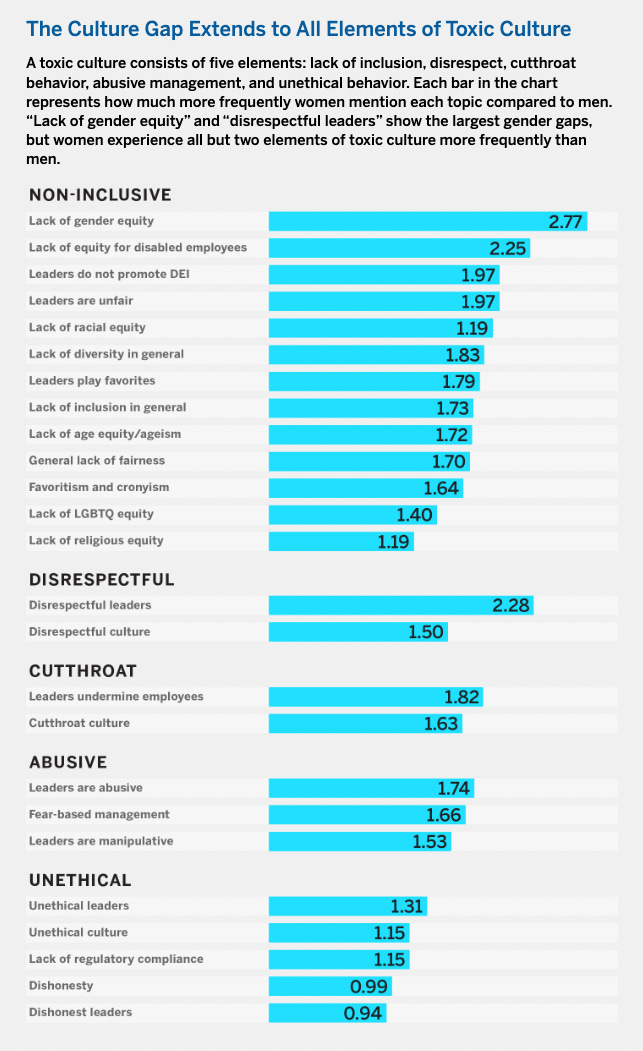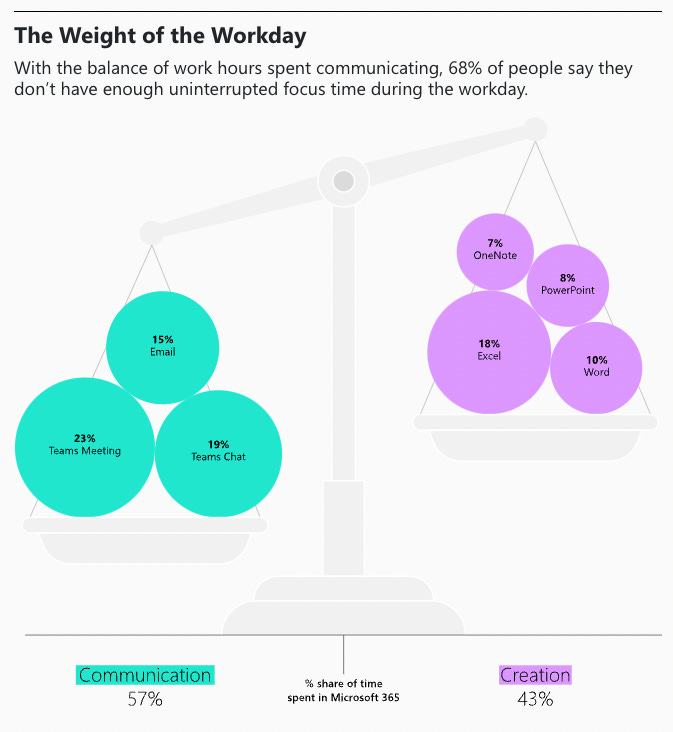
Quote of the Moment
We are drowning in information while starving for wisdom.
| E. O. Wilson
As we shall see in Too Much Of A Good Thing, below, we are drowning in chat.
Toxic Culture
In The Toxic Culture Gap Shows Companies Are Failing Women, Donald Sull and Charles Sull have researched men's and women’s perspectives on work culture and discovered an enormous difference in women’s perception of corporate culture as being toxic. And of course, that means toxic to women.
Toxic Culture Is the Largest Culture Gap Between Women and Men
An analysis of 600,000 Glassdoor reviews from 2020 and 2021 shows how women and men experience corporate culture differently. The vertical axis shows the percentage of women who mentioned a topic in their reviews, and the horizontal axis measures relative sentiment, or how much more or less positively women talked about these themes compared with men.
Women generally spoke more negatively about elements of culture than men, including colleagues, agility, technology, and compensation and benefits. But, oh my god, look at toxic culture, an enormous outlier. The researchers note that women mentioned toxic culture 1.41 times more frequently than men, and then state the bottom line.
Toxic culture is not only an outlier in terms of the sentiment gap between women and men; it also imposes high costs on organizations and individuals. In an earlier study, we found that a toxic culture was 10 times more powerful than compensation in predicting attrition during the first six months of the so-called Great Resignation.8 Even if they don’t quit, employees in toxic environments are more likely to disengage from their work, exert less effort, and bad-mouth their employer to others.9
More importantly, toxic cultures exact a dreadful toll on their victims. Sustained exposure to a toxic culture increases the odds that employees will suffer from anxiety, depression, burnout, and serious physical health issues.10 As Brené Brown noted in the Dare to Lead podcast episode in which we discussed our research, toxicity affects employees on a deeper emotional level than most other elements of the employee experience.
And the gap extends to every element making up a toxic culture.
Skimming the list what sticks out is… bad bosses. Disrespectful, cutthroat, abusive, manipulative, unethical, and dishonest bosses.
Full stop.
There is hope (hard to imagine, but the researchers are optimists):
The severity and magnitude of the toxic culture gender gap is unequivocally bad news, but there is good news as well: There are concrete steps that leaders can take to narrow the gap relatively quickly. In our work helping companies improve corporate culture, we have seen leaders successfully address the toxic culture gap between women and men, often making progress within a few quarters.
In our article “How to Fix a Toxic Culture,” we laid out dozens of evidence-based ways that leaders at every level — from the C-suite to front-line supervisors — can root out toxicity. Many of these interventions can deliver immediate improvements.
But it seems like toxic culture is endemic, despite the authors’ belief in the possibilities of change, because the supply of bad bosses is inexhaustible.
Factoids
Forty-six percent of retirees reported this year that they left the workforce earlier than planned | Employee Benefits Research Institute
…
More Than 2 Million Households Dissolved (then Reappeared) During the Pandemic: Single-person households accounted for 61 percent of the 2.5 million households that dissolved in early 2020 and 82 percent of the 4.5 million households that formed thereafter.
…
Vertical farms are the new agricultural frontier: modern systems use up to 98% less water compared to traditional farming techniques. Neither weeds nor bugs can get into the sealed unit, so there’s no need for pesticides or herbicides, and production can’t be derailed by drought or floods. (via Dense Discovery)
Too Much Of A Good Thing
Microsoft’s Work Trend Index 2023 reveals sad numbers, and a new buzzword: digital debt.
We’re all carrying digital debt: the inflow of data, emails, meetings, and notifications has outpaced humans’ ability to process it all. And the pace of work is only intensifying. Everything feels important, so we spend our workdays trying to get out of the red. Nearly 2 in 3 people (64%) say they struggle with having the time and energy to do their job—and those people are 3.5x more likely to also struggle with innovation and strategic thinking. And nearly 2 in 3 leaders (60%) are already feeling the effects, saying that a lack of innovation or breakthrough ideas on their teams is a concern. There are only so many minutes in the day—and every minute we spend managing this digital debt is a minute not spent on the creative work that leads to innovation. In a world where creativity is the new productivity, digital debt is more than an inconvenience—it’s impacting business.
People are spending so much time communicating with others that they have little heads-down time to actually do work.
42% of the workday of those surveyed was spent in Teams, either Teams Meetings or Teams Chat.
This is lunacy.
I don’t think this should be considered ‘digital debt’, a term that suggests it can be paid back, in some way. Better to consider it as a tax, or in public health terms, a disease.
There is copious research to show that companies should be much more deliberate in communications policy. As one example, as I wrote recently in True Async:
On a personal level, we are fighting for time. One way to think about it in the work context is the distinction between me-time and we-time:
Me-time is when individuals are focused on deep work -- writing, thinking, programming, planning, designing -- it's just someone working alone with the tools and artifacts of their trade.
We-time is when we are involved in communications with others -- meetings, calls, and working sessions; 1:1 or 1:many -- where the focus of the participants is split between the topic at issue (like discussing a project) and the many social aspects of the interaction (negotiation, arguing for and against ideas or propositions, establishing how the project will impact the project participants, and other social aspects of the topic at issue).
Clearly, organizations have a strong incentive to counter the trend of time poverty, help workers concentrate on me-time, and drastically minimize we-time. But how?
Researchers Christoph Riedl and Anita Williams Woolley make a clear case for collectively defending me-time at the organizational level. The key is 'burstiness': a regime concentrating as much communication into as narrow a timeframe as possible:
Our research suggests that such bursts of rapid-fire communications, with longer periods of silence in between, are hallmarks of successful teams. Those silent periods are when team members often form and develop their ideas — deep work that may generate the next steps in a project or the solution to a challenge faced by the group. Bursts, in turn, help to focus energy, develop ideas, and achieve closure on specific questions, thus enabling team members to move on to the next challenge.
Note that their argument is not a one-sided defense of individual me-time (a case I made in Fighting for Time). Instead, they observe that bursty communications are characteristic of high-performing teams. It's about the network effects of the group adopting a shared mindset about cramming as much communication as possible into a small window, where everyone is available and reacting to others' comments, questions, and concerns, making agreements, and moving ahead.
Returning to the madness of the Microsoft report:
Keep reading with a 7-day free trial
Subscribe to Work Futures to keep reading this post and get 7 days of free access to the full post archives.




